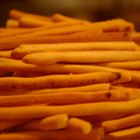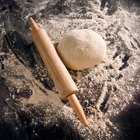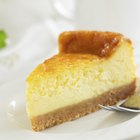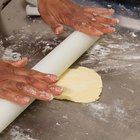
A crust done to perfection determines the success or flop of a homemade pizza. Whether thick or thin, a good crust must be firm enough to hold your toppings, without being dry or overdone. If a golden brown crust has so far eluded you, make adjustments to your dough recipe, pizza-making techniques or oven temperature.
Play With Flours
Because homemade pizza dough has so few ingredients, the quality of each is important to achieving a golden crust. Italian bakers rely on a finely ground, low-gluten flour known as Italian Caputo OO. The double zeros refer to the light texture of this flour, ideal for achieving a pizza crust with just the right amount of crunch. Another baker’s secret is malt flour. One teaspoon of non-diastatic malt flour -- also known as malt powder – gives pizza a shiny, brown crust. Malt powder marked diastatic improves the dough's rising and adds flavor.
Wrestling and Resting
Pizza crust tastes and looks best when made from moist dough. It can be tempting to add more flour when kneading your dough, but in this case, sticky is good. Only add flour a tablespoon at a time, just to keep it manageable. When shaping your pizza, the dough at this point can get tough and hard to handle. Improper shaping of your crust can cause uneven browning, because some parts of your crust will be thicker than others. Give your dough a few minutes of rest between each step of the shaping process. This allows the gluten to relax a bit so the dough is easier to handle.
Brushing the Crust
If your crust is cooking to the desired doneness but still appears pale and unappetizing, brush the edges with cream. The high amount of milk fat in heavy cream adds rich flavor and a golden crispness to your crust. Use a pastry brush and apply it to the outer edges of the crust just before baking, then brush again about halfway through baking. Melted butter can also be used, or try olive oil for a non-dairy browning alternative.
Preheating the Oven
The most important factor to achieving good crust is a hot oven. In his book, “How to Cook Everything Vegetarian,” Mark Bittman recommends 500 degrees Fahrenheit or hotter if your oven is capable. Allow at least 30 minutes for your oven to get hot before sliding the pizza inside. If you are using a pizza stone, make sure it is fully heated before you use it. When baking pizza on baking sheets such as those used for cookies, grease them first with a bit of oil to keep your dough from sticking.
Related Articles

What to Do With Pizza Dough When You're ...

How to Make Bread Chewy
Why Are My Biscuits Always Flat?

What Does Brushing Pizza Crust With ...

How to Make Thin Extra Crispy Pizza ...

How to Add Gluten to All-Purpose Flour

How to Freeze an Unbaked Pizza Crust

What Temperature to Cook Scones?
Easy Cinnamon Roll Recipe

Can I Substitute Bleached for ...

How to Make Bread Sticks Out of Pizza ...
Secret to Making Soft Chewy Italian ...

Chocolate Chip Cookie Dough Brownies

How Long to Bake a Pizza With Lots of ...

How to Make Your Pizza Crust Crispy

How to Substitute Cornstarch for ...

What Are the Causes of Pie & Pastry ...

How to Preserve Dough That Has Risen

Gluten-Free Cheesecake Nut Crust

How to Make Puerto Rican Empanada Dough ...
References
- Splendid Table: How do you make a pizza crust golden brown?
- How to Cook Everything Vegetarian; Mark Bittman
- Saveur: The Best Flour For Making Pizza
- California Dairy Advisory Board: Cream
- Pizza Today: Dough Doctor
Writer Bio
For more than 10 years, Carol Butler has run a small, off-grid furniture business with her husband and is a regular contributor to the Edible community of magazines. As staff writer for RichLife Advisors, she covers financial planning and other industry-related topics. She holds a B.F.A. in theater arts.
Photo Credits
Visage/Stockbyte/Getty Images